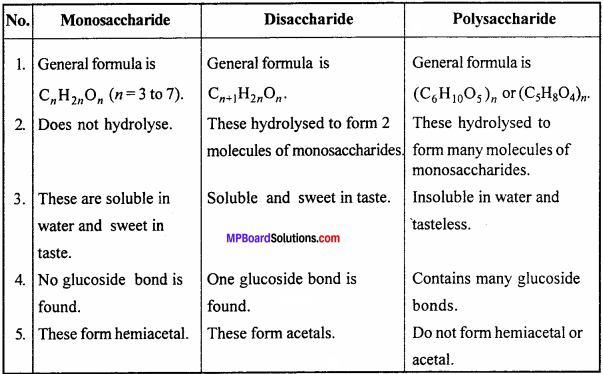MP Board Class 12th Chemistry Solutions Chapter 14 Biomolecules
Biomolecules NCERT Intext Exercises
Question 1.
Glucose or sucrose are soluble in water but cyclohexane or benzene (simple six membered ring compounds) are insoluble in water. Explain.
Answer:
Benzene and cyclohexane are neither polar nor possess – OH groups. Therefore, they are not able to form H- bonding with water molecule hence, insoluble in water. Glucose and sucrose are polar molecules. Further, they contain large number of – OH groups (five in case of glucose and eight in case of sucrose). They form extensive H-bonding with water molecule and are thus soluble in water.
Question 2.
What are the expected products of hydrolysis of lactose ?
Answer:
Galactose and glucose are the products of hydrolysis of lactose.

Question 3.
How do you explain the absence of aldehyde group in the penta acetate of D-glucose ? ,
Answer:
When glucose (α) or (β) is treated with acetic anhydride it forms a penta acetyl derivative which does not contain a free – OH group at C – l, it cannot be hydrolysed in aqueous solution to give open-chain aldehyde form and hence glucose penta-acetate does not react with NHC2OH to form glucose oxime.
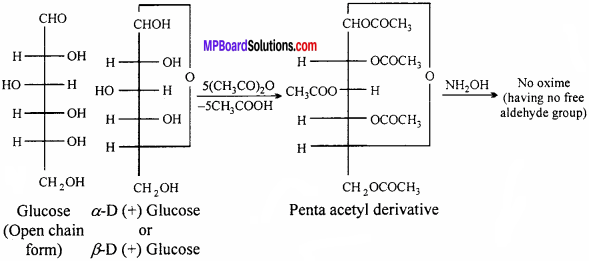
Question 4.
The melting points and solubility in water of amino acids are generally higher than that of the corresponding haloacids. Explain.
Answer:
The amino acids exist as Zwitter ions![]() Due to this dipolar salt like character they have strong dipole – dipole attractions or electrostatic attractions. There fore, their melting points are higher than haloacids which do not have salt like character. Further, due to salt like character, they interact strongly with H2O. As a result, solubility in water of amino acids is higher than that of the corresponding haloacids which do not have salt like character.
Due to this dipolar salt like character they have strong dipole – dipole attractions or electrostatic attractions. There fore, their melting points are higher than haloacids which do not have salt like character. Further, due to salt like character, they interact strongly with H2O. As a result, solubility in water of amino acids is higher than that of the corresponding haloacids which do not have salt like character.
Question 5.
Where does the water present in the egg go after boiling the egg ?
Answer:
When egg is boiled, the denaturation of protein and then coagulation takes place probably through H-bonding. Water present in the egg gets absorbed or adsorbed during denaturation and disappears. In this process, the globular protein in egg changes to insoluble fibrous protein.
Question 6.
Why cannot vitamin C be stored in our body ?
Answer:
Vitamin C is soluble in water. It cannot be stored in our body because it is easily excreted in urine.
Question 7.
What products would be formed when a nucleotide from DNA containing thiamine is hydrolysed ?
Answer:
Hydrolysis products:
2 – deoxy – D – ribose (Sugar) + Thiamine (Base) + Phosphoric acid.
Question 8.
When RNA is hydrolysed, there is no relationship among the quantities of different bases obtained. What does this fact suggest about the structure of RNA ?
Answer:
When RNA is hydrolysed, there is no relationship between the quantities of four bases, i.e., cytosine (C), guanine (G), adenine (A) and uracil (U) are obtained, therefore, the base pairing principle, i.e., (A) pairs with (T) and (C) pairs with (G) is not followed (as in DNA). This suggest that unlike DNA (a double stranded structure), the RNA has a single stranded molecule.
Biomolecules Ncert Textbook Exercises
Question 1.
What are monosaccharides ?
Answer:
Monosaccharides are the carbohydrates which cannot be hydrolysed further to give simpler units of poly hydroxy aldehydes or ketones.
Question 2.
What are reducing sugars ?
Answer:
Reducing sugars are carbohydrates which reduce Fehling solution to red precipitate of CH2O and Tollen’s reagent to shining metallic silver. All monosaccharides (both aldoses and ketoses) and disaccharides, except sucrose are reducing sugar. Thus, D-(+)- glucose, D – (+) galactose, D-(-) fructose, D-(+) -maltose and D-(+) -lactose are reducing sugars.
Question 3.
Write two main functions of carbohydrates in plants.
Answer:
- Cellulose is a predominant constituent of cell wall of plant cells.
- Starch is the main food storage polysaccharide of plants.
Starch is stored in seeds and acts as the reserve food material for the small plant unless it is capable of making its own food by photosynthesis.
Question 4.
Classify the following into monosaccharides and disaccharides: Ribose, 2-deoxyribose, maltose, galactose, fructose and lactose.
Answer:
Monosaccharide: Ribose, 2-deoxyribose, galactose and fructose.
Disaccharide: Maltose and lactose.
![]()
Question 5.
What do you understand by the term glycosidic linkage ?
Answer:
The oxygen (ethereal) linkage through which two monosaccharide units are joined together by the loss of a water molecule to form a molecule of disaccharide is called glycosidic linkage. For example, sucrose (a disaccharide) is composed of C1 of α – glucose and C2 of β – fructose through the glycosidic linkage.
![]()
Question 6.
What is glycogen ? How is it different from starch ?
Answer:
(i) The carbohydrates are stored in animal body as glycogen. It is present in liver, muscles and brain. Enzymes break the glycogen down to glucose when the body needs glucose.
(ii) Glycogen is more highly branched than amylopectin (starch) glycogen chain consist of 10-14 glucose units, whereas amylopectin (starch) glycogen chain consist of 20-25 glucose units.
Question 7.
What are the hydrolysis products of:
1. Sucrose
2. Lactose
Answer:
1. Glucose and fructose:

2. D-Glucose and D-Galactose:

Question 8.
What is the basic structural difference between starch and cellulose ?
Answer:
Starch consists of two components :
amylose and amylopectin. Amyiose is a long linear polymer of 200-1000 α-D-(-) glucose units held by C1 – C4 glycosidic linkage. It is soluble in water. Amylopectin is a branched chain polymer of α-D-(+) glucose linkage whereas branching occurs by C1– C6 glycosidic linkage. It is insoluble in water. On the other hand cellulose is a straight chain polysaccharide composed only of β – D- (+) glucose units which are formed by glycosidic linkage between C1 of one glucose unit and C4 of next glucose unit.
Question 9.
What happens when D – glucose is treated with the following reagents:
(i) HI
(ii) Bromine water
(iii) HNO3?
Answer:
(i) When glucose is treated with HI, it forms n-hexane, suggesting that all the six carbon atoms are linked in straight chain.

(ii) On heating glucose with bromine water, it gets oxidized to six carbon carboxylic acid, gluconic acid.
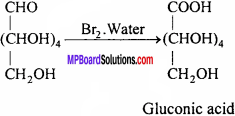
(iii) Glucose on treatment with nitric acid gives a dicarboxylic acid, saccharic acid.
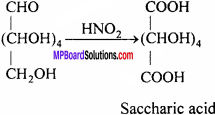
Question 10.
Enumerate the reactions of D-glucose which cannot be explained by its open chain structure.
Answer:
Following reactions could not be explained by open chain structure of D – glucose:
- The penta-acetate of glucose does not react with hydroxylamine indicating the absence of free – CHO group.
- Despite having the aldehyde group
- Glucose does not form the hydrogen sulphide addition product with NaHSO3.
- Glucose does not give Schifts test.
Question 11.
What are essential and non-essential amino acids ? Give two examples of each type.
Answer:
(a) Essential amino acids:
The amino acids which our body cannot make and must be obtained through diet.
Examples:
Valine, Isoleucine, Arginine, Lysine, Threonine etc.
(b) Non-essential amino acids:
These are the amino acids which our body can make.
Examples:
Glycine, Alanine, Glutamic acid, Aspartic acid, Glutamine, Serine etc.
![]()
Question 12.
Define the following as related to proteins :
(i) Peptide linkage
(ii) Primary structure
(iii) Denaturation.
Answer:
(i) Peptide linkage:
A peptide bond is an amide linkage formed between – COOH group of one a-amino acid and NH2 group of the other a-amino acid by loss of a molecule of water. It units two amino acids unit in a peptide bond (molecule).

(ii) Proteins are the polymers of a-amino acids. These polymers (also known as polypeptide) consist of amino acids linked with each other in a specific sequence. This sequence of amino acids is known as the primary structure of proteins. Any change in this sequence of amino acids (i.e., primary structure) creates a different proteins.
(iii) A process that changes the physical and biological properties of proteins without affecting the chemical composition of proteins is called denaturation. The denaturation is caused by certain physical and chemical treatment such as changes in pH, temperature, presence of some salts or certain chemical agents.
Question 13.
What are the common types of secondary structure of proteins ?
Answer:
The conformation of polypeptide chain assumed as a result of hydrogen bonding is called secondary structure of proteins. The two types of secondary structures are a-helix and β – pleated sheet structure. (For detail refer your NCERT text-book.)
Question 14.
What type of bonding helps in stabilizing the a-helix structure of proteins ?
Answer:
![]()
(Refer your NCERT text-book for details and structure.)
Question 15.
Differentiate between globular and fibrous proteins.
Answer:
Difference between globular and fibrous protein:
Globular protein:
- They have foilded ball like structure.
- They have three-dimensional structure
- They are soluble in water and aq. solution of salt and base.
- These proteins are inactive towards temperature and pH value.
Fibrous protein:
- These molecule have long threads like structure.
- They have sheet like structure.
- These are insoluble in water.
- Fibrous protein are active towards temperature and pH value.
Question 16.
How do you explain the amphoteric behaviour of amino acids ?
Answer:
Due to dipolar or Zwitter’s ion structure, amino acids are amphoteric in nature. The acidic character of the amino acids is due to the – NH3 group and the basic character is due to the – COOH group as shown below:
Acidic character:

Basic character:

Question 17.
What are enzymes ?
Answer:
The enzymes are globular proteins which act as bio-catalyst. They are very specific and efficient in their action. Almost all the reactions that occur in the body are catalyzed by enzymes.
Question 18.
What is the effect of denaturation on the structure of proteins ?
Answer:
During denaturation, 2° and 3° structures of proteins are destroyed but 1° structure remains intact. As a result of denaturation, the globular proteins (soluble in H2O) are converted into fibrous proteins (insoluble in H2O)) and their biological activity is lost. The coagulation of egg white on boiling is a common example of denaturation.
![]()
Question 19.
How are vitamins classified ? Name the vitamin responsible for the coagulation of blood.
Answer:
On the basis of solubility in water or fat, the vitamins are generally classified into two types:
- Water soluble vitamins:
These include vitamin B-complex. (B1 B2, B3, B4, B6, B12 and nicotinic acid etc.) and vitamin C etc. - Fat soluble vitamins:
These include vitamins A, D, E and K. Liver cells are rich in fat soluble vitamins. Vitamin K is responsible for coagulation of blood.
Question 20.
Why are vitamin-A and vitamin-C essential to us ? Give their important sources.
Answer:
Vitamin – A:
It is essential for us because its deficiency causes Night blindness and Xerophthalmia (Hardening of cornea of eye).
Sources:
Carrots, milk, butter, fish liver oil, egg yolk, green and yellow vegetables.
Vitamin – C:
It is essential for us because its deficiency causes Scurvy (bleeding gums), Tooth decay’s and Pyorrhoea etc.
Sources:
Lemon, orange (citrous fruits), amla, tomatoes, potatoes and green leafy vegetables.
Question 21.
What are nucleic acids ? Mention their two important functions.
Answer:
Nucleic acids are long chain polymers of nucleotides. They are also called poly-nucleotides. Nucleic acids are mainly of two types, the deoxyribonucleic acid (DNA) and ribonucleic acid (RNA).
Functions:
(i) DNA is responsible for transmission of hereditary effects from one generation to another. This is due to unique property of replication, during cell division and two identical DNA strands are transferred to the daughter cells.
(ii) DNA and RNA are responsible for synthesis of all proteins needed for the growth and maintenance of our body. Actually, the proteins are synthesized by various RNA molecules (m-RNA and t-RNA etc.) in the cell but the message for the synthesis of a particular protein is present in DNA.
Question 22.
What is the difference between a nucleoside and a nucleotide ?
Answer:
A nucleoside contains only basic component of nucleic acids namely a pentose sugar and a nitrogenous base. A nucleotide contains all the three basic components of nucleic acids namely a phosphoric acid group, a pentose sugar and a nitrogenous base.
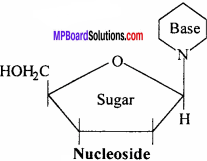
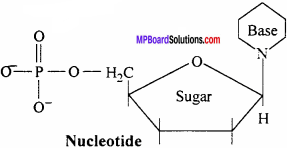
Question 23.
The two strands in DNA are not identical but are complementary. Explain.
Answer:
The two strands in DNA molecule are held together by hydrogen bonds beetween purine base of one strand and pyrimidine base of the other and vice-versa. Because of different sizes and geometries of the bases, the only possible pairing in DNA are G (guanine) and C (cytosine) through three H-bonds i.e., (C = G) and between A (adenine) and T (thiamine) through two H-bonds i.e., (A=T) (for figure refer your NCERT text book). Due to this base pairing principle, the sequence of bases in one strand automatically fixes the sequence of bases in the other strand. Thus, the two strands are complimentary and are not-identical.
![]()
Question 24.
Write the important structural and functional differences between DNA and RNA.
Answer:
Differences between DNA and RNA:
DNA:
- Occurs mainly in the nucleus of the cell.
- It contains the sugar deoxyribose.
- Does not contain nitrogenous base, uracil.
- It has a double strand helix
- It is responsible for the transmission of heredity character.
- Alkaline hydrolysis is quite slow.
- Ratio A/T = 1 and G/C = 1.
RNA:
- Occurs in the cytoplasm of the cell.
- It contains the sugar ribose.
- Does not contain nitrogenous base thymine.
- It has double as well as single strand helix.
- It helps in protein biosynthesis.
- Alkaline hydrolysis takes place readily.
- Such ratio is not present.
Question 25.
What are the different types of RNA found in the cell ?
Answer:
There are three types of RNAs:
- Ribosomal RNA (r-RNA)
- Messenger RNA (m-RNA)
- Transfer RNA (t-RNA).
![]()
Biomolecules Other Important Exercises
Biomolecules Objective Type Questions
Question 1.
Choose the correct answer:
Question 1.
Which protein transports oxygen in blood flow:
(a) Haemoglobin
(b) Insulin
(c) Albumin
(d) Myoglobin.
Answer:
(d) Myoglobin.
Question 2.
Beri-beri diseases is caused due to deficiency of which vitamin:
(a) Vitamin – A
(b) Vitamin – C
(c) Vitamin – B2
(d) Vitamin – D
Answer:
(c) Vitamin – B2
Question 3.
Enzyme which enhances the conversion of glucose to ethanol is:
(a) Zymase
(b) Invertase
(c) Maltase
(d) Diastase.
Answer:
(a) Zymase
Question 4.
In human body carbohydrate is stored:
(a) In the form of glucose
(b) In the form of glycogen
(c) In the form of starch
(d) In the form of fructose.
Answer:
(b) In the form of glycogen
Question 5.
Change in optical rotation of a freshly prepared solution of sugar after some time is called:
(a) Optical activity
(b) Inversion
(c) Specific rotation
(d) Mutation.
Answer:
(b) Inversion
Question 6.
Formula of most familiar disachharide is:
(a) C10H18O9
(b) C10H20O10
(c)C18H22O11
(d) C12H22O11.
Answer:
(d) C12H22O11.
![]()
Question 7.
The following statement is false in relation to Ribose:
(a) It is a polyhydroxy compound
(b) It is a aldehydic sugar
(c) It contain 6 carbon atoms
(d) It has optical rotation.
Answer:
(c) It contain 6 carbon atoms
Question 8.
In the formation of carbohydrate are required:
(a) 2 carbon
(b) 3 carbon
(c) 4 carbon
(d) 6 carbon.
Answer:
(d) 6 carbon.
Question 9.
Haemoglobin is:
(a) Enzyme
(b) Globular protein
(c) Vitamin
(d) Carbohydrate.
Answer:
(d) Carbohydrate.
Question 10.
Which carbohydrate is an essential constituent of plant cells:
(a) Cellulose
(b) Starch
(c) Sucrose
(d) Vitamin.
Answer:
(b) Starch
Question 11.
How many subunits are present in haemoglobin:
(a) 2
(b) 3
(c) 4
(d) 5.
Answer:
(b) 3
Question 12.
Starch is a polymer of:
(a) Glucose
(b) Sucrose
(c) Both (a) and (b)
(d) None of these.
Answer:
(a) Glucose
![]()
Question 13.
Which sugar is present in maximum amount in human blood:
(a) d-fructose
(b) d-glucose
(c) Sucrose
(d) Lactose.
Answer:
(b) d-glucose
Question 14.
Element present in Vitamin B12 is:
(a) Pb
(b) Zn
(c) Fe
(d) CO.
Answer:
(d) CO.
Question 15.
Amount of glucose in blood is determined by:
(a) Tollen’s reagent
(b) Benedict solution
(c) Alkaline iodine solution
(d) Bromine water.
Answer:
(b) Benedict solution
Question 16.
Deficiency of which Vitamin causes rickets:
(a) Vitamin C
(b) Vitamin B
(c) Vitamin A
(d) Vitamin D.
Answer:
(d) Vitamin D.
Question 17.
In metabolic processes which of the following provide maximum energy :
(a) Protein
(b) Vitamin
(c) Thiamine
(d) Pyrimidine.
Answer:
(d) Pyrimidine.
Question 18.
Vitamin B1 is:
(a) Riboflavin
(b) Cobaltamine
(c) Thiamine
(d) Pyrimidine.
Answer:
(a) Riboflavin
![]()
Question 19.
Deficiency of Vitamin C leads to:
(a) Scurvy
(b) Rickets
(c) Pyorrhoea
(d) Anaemia.
Answer:
(a) Scurvy
Question 20.
Most effective energy reservoir in a living cells is:
(a) A.M.P.
(b) A.T.P.
(c) A.D.P.
(d) U.D.P.
Answer:
(b) A.T.P.
Question 21.
Disaccharide present in milk is:
(a) Sucrose
(b) Lactose
(c) Maltose
(d) Cellulose.
Answer:
(b) Lactose
Question 22.
Which is not glyceroid:
(a) Fat
(b) Oil
(c) Phospholipid
(d) Soap.
Answer:
(d) Soap.
Question 23.
Which is not found in R.N.A.:
(a) Thymine
(b) Uracil
(c) Adenine
(d) Guanine.
Answer:
(a) Thymine
Question 24.
Enzymes are:
(a) Nitrogen containing complex compound
(b) Carbohydrate
(c) Co-ordination compounds
(d) Metallic compound.
Answer:
(a) Nitrogen containing complex compound
Question 25.
Chemical name of vitamin C is:
(a) Cyano cobaltamine
(b) Ascorbic acid
(c) Tocopherol
(d) Biotin.
Answer:
(b) Ascorbic acid
![]()
Question 2.
Fill in the blanks:
- By the oxidation of glucose …………… molecules of ATP are produced.
- The breaking of complex molecules in organisms is known as ……………
- In hyperglycaemia the amount of …………… in blood increases.
- Deficiency of …………… leads to eye disease.
- Deficiency of iodine leads to …………… disease.
- Blood …………… the temperature of the entire body.
- …………… hormone balances the amount of sugar in blood.
- …………… is responsible for the clotting of blood.
- Denaturation does not affect …………… structure of protein.
- Protein is a polymer of ……………
- …………… is the basic unit of protein.
- …………… is not present in D.N.A.
- Haemoglobin is a …………… compound of iron.
- Oil and fats obtained from organisms are known as ……………
Answers:
- 38
- Catabolism
- Sugar
- Vitamin A
- Goitre
- Balance
- Insulin
- Vitamin K
- Primary
- Amino acids
- Amino acid
- Uracil
- Complex
- Lipid.

Question 3.
Match the following:
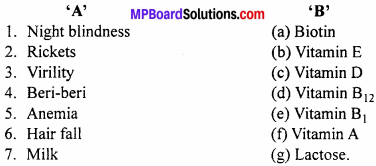
Answer:
- (f) Vitamin A
- (c) Vitamin D
- (b) Vitamin E
- (e) Vitamin B
- (d) Vitamin B12
- (a) Biotin
- (g) Lactose.
Question 4.
Answer in one word / sentence:
- Write the chemical name of Vitamin C.
- Tell the source of Vitamin K.
- Is responsible for clotting of blood ?
- Which bond links amino acids together ?
- How many amino acids are synthesized by human body ?
- Cellulose is a linear polymer of which glucose ?
- In RNA molecule which pyrimidine is present in place of Thymine ?
- Lactose on hydrolysis gives.
- Glucose contains Pyranose ring whereas Fructose contain.
- In polysaccharides, monosaccharide units are linked to each other by which bond ?
- Which protein helpful for clotting of blood known as ?
- Write one example of Monosaccharide Carbohydrate.
- What is the name of Disaccharides sugar present in milk ?
Answers:
- Ascorbic acid
- Green leafy vegetables
- Vitamin K (Phylloquinone)
- Peptide bond
- Ten
- 2-glucose
- Uracil
- Glucose and Lactose
- Furanose ring
- Glycosidic
- Fibrinogen
- Glucose or Fructose
- Lactose.
![]()
Biomolecules Short Answer Type Questions
Question 1.
What is the effect of deficiency of proteins on our body ?
Answer:
Deficiency of protein causes following diseases:
- Anaemia:
The deficiency of haemoglobin protein in the body creates lack of enough blood which causes paleness in body. - Kwashiorkar:
This disease is mainly found in children, in this body of patient swells up and deforms.
Question 2.
Define carbohydrates.
Answer:
Substances which are polyhydroxy aldehydes or polyhydroxy ketones or which give these compounds on hydrolysis are called carbohydrates.
Question 3.
Write the chemical name formula source and disease caused by Vitamin ‘C
Answer:
- Chemical name of Vitamin ‘C’:
Ascorbic acid Source of Vitamin ‘C’: Green vegetables, salad, citrus fruits. - Disease caused by Vitamin ‘C’:
Scurvy, spongy and bleeding gums. Formula of Vitamin ‘C’: C6H8O6.
Question 4.
Write the diseases which caused by the following Vitamins:
(a) Vitamin-A, (b) Vitamin-B, (c) Vitamin-D, (d) Vitamin-E.
Or,
Write the functions of the following vitamins:
(a) Vitamin-A, (b) Vitamin-D, (c) Vitamin-E, (d) Vitamin-K.
Answer:
Diseases caused by the above Vitamins:
(a) Vitamin-A : Night blindness
(b) Vitamin-B : Beri-beri, loss of appetite and vigour
(c) Vitamin-D : Rickets, osteomalacia
(d) Vitamin-E : Loss of reproductive ability.
Functions caused by the above Vitamins :
(a) Vitamin-A : For vision and growth develops resistance against diseases.
(b) Vitamin-D : For bones, control of metabolism of calcium and phosphorus.
(c) Vitamin-E : Virility in man and reproduction.
(d) Vitamin-K : Coagulation of blood.
![]()
Question 5.
Give the names and functions of any four proteins.
Answer:
Proteins and their functions:
(1) Haemoglobin : Transport of oxygen from lungs to different tissues of body.
(2) Myosin : For motion of muscles
(3) Pepsin : As a catalyst in bio-chemical reactions
(4) Keratin : Present in hairs, nails and teeth.
Question 6.
What are enzymes ? Give applications.
Answer:
Enzymes are complicated organic molecules which are produced by living cells and are also called biological catalysts. They are complex nitrogenous molecules, unlike inorganic catalysts, they take part in the reaction and get destroyed.
Example:
Enzyme invertase catalyse the hydrolysis of sucrose.

Factors affecting the activity of catalyst:
- Temperature
- pH
- Concentration of enzyme
- Concentration of substance
- Concentration of the product formed.
Functions of enzymes:
Enzymes play a very important role in many biological reactions. The names of some important enzymes and the biochemical reactions catalysed by them are given below:
1. Role of enzymes in the process of digestion:
Enzymes play an important role in digestion resulting in breakdown of macro molecules into simple molecules.
2. Industrial applications:
Enzymes play an important role in many industrial processes such as manufacture of ethanol from sugar or starch, manufacture of acetic acid, manufacture of cheese, leather, tanning, etc.
Question 7.
What are monosaccharides ? Explain with examples.
Answer:
These are the simplest carbohydrates which cannot be hydrolysed into small molecules. Their general formula is CnH2nOn (there are some exceptions also). Here n = 2 to 10. These are sweet in taste and soluble in water. These contain either one – CHO group or one > C = O group.
Aldopentose – Ribose, Zylose etc. (C5H10O5)
Aldohexose – Glucose, Galactose, Mannose etc. (C6H12O6)
Ketohexose – Fructose, Sorbose etc. (C6H12O6).
![]()
Question 8.
What are proteins ?
Answer:
The word protein is derived from the greek word protious (Protious = to take the first) i.e. first or very important. Proteins are high molecular mass nitrogen containing complex organic compounds found in the protoplasm of all animal and plants.
Chemically protein is the condensation polymer of a-amino acid.
Question 9.
What are carbohydrates ? Which unit of carbohydrate provide energy to human body ?
Answer:
Carbohydrates are compound of carbon, hydrogen and oxygen. General formula of carbohydrate is (CxH2O)y where x and y are integers. These compounds have ratio of hydrogen and oxygen 2: 1 like water (H2O). Therefore the name of these compounds is given carbohydrates. Examples of carbohydrates are glucose (C6H12O6), fructose (C6H12O6), sucrose (C12H22O11) etc.
Glucose is the unit of carbohydrates which is responsible to provide energy. Glucose decomposes slowly with the help of oxydase enzyme present in the body into CO2 and water. Energy is released in this process.
![]()
Question 10.
What are essential and non-essential amino acids ? Give two examples of each type.
Answer:
Essential Amino Acid: Amino acids which are not synthesized in our body but have to be taken in our food are known as essential amino acid.
Example: Valine, Neucline, Alinine etc.
Non-essential Amino Acid: Amino acids which can be synthesized in our body are known as non-essential amino acid.
Example: Glycine, Glutamic acid.
Question 11.
Explain the formation of amide and peptide bonds in the structure of proteins.
Answer:
(1) Amide bond:
Protein is a complicated organic compound which is formed by the combination of different amino acids. When the – CONH – link resulting from the reaction between a compound containing a carboxylic group (- COOH) and that with an amine group (- NH2) it forms a amide bond.

(2) Peptide linkage:
When the – CONH – like resulting from the reaction between two molecules of a-amino acids, is called peptide bond. Such a bond involves only the alpha amino and a-carboxylic group. Thus, two molecules of a-amino acid on reaction yields a peptide bond.
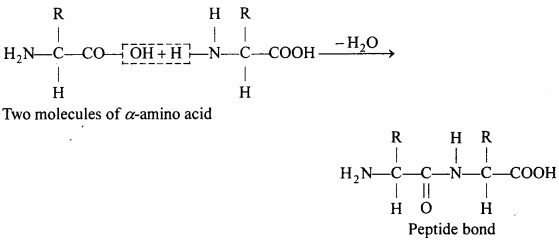
Question 12.
Define polysaccharides. Give examples also.
Answer:
Polysaccharides are natural isomers which have molecular weight up to many lacks, General formula of polysaccharides is (C6H10O5)n where value of n is from 12 to thousands. These are complex material which are formed by condensations of monosaccharides. These compounds contain glycocydic bonds.
Example : Starch, cellulose etc.
![]()
Question 13.
What is invert sugar ?
Answer:
Cane – sugar is dextro – rotatory [D or +] which gives equimolar mixture of monosaccharides. This mixture is laevorotatory [D or-]. Hence the mixture of glucose and fructose obtained as a result of hydrolysis of cane-sugar is called as invert sugar.
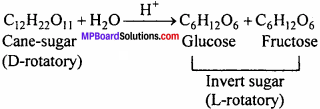
Question 14.
What are disaccharides ? Write general formula of disaccharides.
Answer:
Disaccharides are sugar which are formed by combination of two monosaccharides by removal of one molecule of water. Both monosaccharides are of hexose type in which one unit is glucose. Thus, disaccharides are of aldose-aldose or aldose-ketose type. General formula of disaccharides is C12H22O11
Example: Sucrose, maltose, lactose etc.
Question 15.
Give the pyranose structure of sucrose and maltose.
Answer:
In sucrose two monosaccharides (glucose and fructose) are combine through a glycosidic bond which is present between C1 of α-glucose and C2 of β-fructose.

Whereas maltose molecule is obtained by the condensation of two glucose molecules.

Question 16.
Clarify the structure of protein.
Answer:
Molecule of protein is made up of amino acids. Basically protein molecules are linear polymers of amino acids. Their entire structure can be expressed in four steps:
- Primary structure:
It provides knowledge of mutual combination of various amino acids in a polypeptide chain. - Secondary structure:
It provides knowledge of conformations of peptide chains of protein. - Tertiary structure:
It explains how protein molecule coils to obtain a specific shape. - Quarternary structure:
By this, arrangement of two polypeptide chains with respect to each other is known.
Question 17.
What do you understand by nucleoside and nucleotide ?
Answer:
Nucleoside: When a purine or pyrimidine base joins with a pentose sugar molecule, then it is known as nucleoside.

Question 18.
What are carbohydrates ? Explain mono, di and polysaccharides with example.
Answer:
Carbohydrates are polyhydric aldehydes or polyhydric ketones or substances which on hydrolysis produce such compounds. The carbohydrates are classified into three major classes on the basis of hydrolysis.
1. Monosaccharides:
These are the simples carbohydrates. They cannot be hydrolysed further to give more simple carbohydrates. Monosaccharides have the general formula (CH2O)n These are crystalline solids, soluble in water and are sweet in taste. Example: Glucose, Fructose.
2. Disaccharides:
Disaccharides are sugar which are formed by combination of two monosaccharides by removal of one molecule of water. Both monosaccharides are of hexose type – in which one unit is glucose. General formula of disaccharides is C12H22O11.
Example: Sucrose, Maltose etc.
3. Polysaccharides:
General formula of polysaccharides is (C6H10O5)n where value of n is from 12 to thousands. These are complex material which are formed by condensation of monosaccharides. Example: Starch, Cellulose etc.
![]()
Question 19.
What happens when protein is denatured ?
Answer:
Denaturation of Protein:
Disruption of tertiary structure of protein is called denaturation. These reactions take place by heating in presence of acids or highly concentrated salts or heavy metals. Denaturation does not affect the primary structure of protein. Denaturation takes place in the rearrangement of secondary and tertiary structures. As a result of this, protein losses its biological actvity.
During denaturation the protein molecule uncoils from an ordered and specific conformation into a more disordered conformation. Denaturation takes place when proteins are heated or treated with acids, bases, alcohols, KI, urea, acetone etc. or when exposed to UV or X-ray radiations.
Question 20.
Write functions of vitamin B and name two diseases caused due to its deficiency.
Answer:
Vitamin B include a group of vitamins which are as follows:
‘Vitamin-B1 (Thiamine), Vitamin – B2 (Riboflavin), Vitamin B3 (Pentothenic acid), Vitamin-B6 (Pyridoxine), Vitamin B12 (Cyano cobalamin)
Vitamin B1 (Thiamine)- Source: husk of rice, green vegetables, egg.
Function: Maintenance of activity of nervous system.
Deficiency disease:
(i) Beri-Beri (swelling in hands and legs).
(ii) Gastric (disorder in digestion).
Vitamin B2 (Riboflavin)- Source: egg yolk, milk etc.
Function: Growth of body.
Deficiency disease: Dermatitis, weakness in eye sight.
Question 21.
What are vitamins ? Name the vitamins whose deficiency lead to following diseases:
- Haemorrhage (No clotting of blood)
- Night blindness
- Anaemia
- Ricket
- Pyrohea
- Loss of reproductive ability
- Convulsions.
Answer:
Vitamins are complex organic molecules which act as essential nutrients for body. Though these vitamins are not formed in our body but deficiency of these vitamins causes various diseases in our body. The vitamins are classified according to solubility.
- Fat soluble vitamins: Vitamin A, D, E and K.
- Water soluble vitamins: Vitamin C and vitamin B complex.
Name the vitamins deficiency lead to following diseases :
- Haemorrhage (No clotting of blood) : Vitamin K (Phylloquinone)
- Night blindness: Vitamin A (Retinol)
- Anaemia: Vitamin B12 (Cyanocobalamin)
- Ricket: Vitamin D (Calciferol)
- Pyorrhoea: Vitamin C (Ascorbic acid)
- Loss of reproductive ability: Vitamin E (a -Tocopherol)
- Convulsions: Vitamin B6 (Pyridoxine).
![]()
Question 22.
Write about the following:
- Testosterone
- Thyroxine
- Insulin
- Cortisone.
Answer:
- Testosterone:
Testosterone hormone is secreted by the gland testes and its function is to control the reproductive organs in males. - Thyroxine:
This hormone is secreted by the thyroid gland. Its function is to control metabolic activity and growth. - Insulin:
Insulin hormone is secreted by pancreas and its function is to control the amount of glucose in the blood. - Cortisone:
Cortisone is secreted by adrenal cortex and its function is to control the metabolism of protein and water.
Question 23.
Write the name of two-two diseases caused due to deficiency of retinol, thiamine, ascorbic acid and riboflavin.
Answer:
Retinol: Night blindness, Xerophthalmia
Thiamine : Beri-Beri, growth of body stops
Ascorbic acid: Scurvy, Tooth loss
Riboflavin: Weak eye sight, dermititis.
Question 24.
Write two-two source of vitamin A and C. Write one-one disease caused due to its deficiency.
Answer:
- Vitamin Source Disease
- Vitamin-A Milk, butter, cheese Night blindness
- Vitamin-C Lemon, Tomato Scurvy.
Question 25.
Write the functions of vitamin A, D, E and K.
Answer:
- Vitamin-A : It participate in the formation of visible pigment named Rhodopsin and Iodopsin.
- Vitamin-D : It is useful in the formation of bones.
- Vitamin-E : It prevents the breaking of RBCs.
- Vitamin-K : It is helpful in the clotting of blood.
Question 26.
Write functions and sources of the following bio-molecules/elements :
- Protein
- Carbohydrates
- Fat
- Calcium.
Answer:
- Protein:
Formation of new tissues, and their repairing with the body
Source: Milk, egg, meat, cheese, fish. - Carbohydrates: Carbohydrates provides energy to the body.
Source: Rice, potato, fruits, cane sugar etc. - Fats: They provides energy to the body.
Source: Ghee, oils, milk, egg. etc. - Calcium: Increase the bones and teeth.
Source: Green leafy vegetables, milk.
![]()
Question 27.
Write two Differences between a – Amino acid and Protein.
Answer:
Differences between a – Amino acid and Protein:
α – Amino acid:
- They are simple compounds having amino and Carboxylic acid group.
- On combining amino acid gives dipeptide,polypeptide and then protein e.g. glucose, lysine etc.
Protein:
- Proteins are complex nitrogenous compounds.
- Protein on hydrolysis gives amino acid. e.g. Haemoglobin, casein etc.
Question 28.
Explain in brief:
(a) Name of two enzymes and their function.
(b) Name of two water soluble enzymes and disease caused due to their deficiency.
Answer:
(a) Name of enzyme and function:
1. Amylase (ptyalin): It converts starch into glucose:
![]()
2. Pepsin: It converts protein into amino acid:
![]()
(b) Water soluble vitamin:
1. Vitamin B1: Thiamine
Deficiency disease: Beri-Beri
2. Vitamin C: Ascorbic acid
Deficiency disease: Scurvy Other examples are vitamin B2, B6, B12 and K.
Biomolecules Long Answer Type Questions
Question 1.
Write a note on Nucleic acid.
Answer:
Nucleic acid:
It is found in nucleus of the cell. It has large amount of phosphorus. Nucleic acid are poly nucleotides which is formed by the combination of various nucle otide units. Each nucleotide is formed by three chemical components:
- Phosphate group
- Pentose ribose sugar or De – oxyribose
- Heterocyclic base: Like derivative of pyrimidine (Thiamine, uracil, cytosine) and derivatives of purine (Adinine and Guanine).
Nucleic acid are of two types:
(A) DNA: De-oxy ribonucleic acid.
(B) RNA: Ribonucleic acid.
Components of DNA:
- De-oxyribose sugar molecule
- Phosphoric acid molecule
- Nitrogenous base:
It is of two types:
- Pyrimidine base: It includes cytosine (C) and Thymine (T)
- Purine base: It includes Adenine (A) and Guanine (G)
Components of RNA:
RNA contains Ribose and nitrogen base like Adenine (A), Guanine (G), Uracil (U) and Cytosine (C).
![]()
Question 2.
What are carbohydrates ? Write its classification and four main functions.
Answer:
Definition:
Optically active polyhydroxy aldehydes or ketones or substances which yield these on hydrolysis are known as carbohydrates.
Example: Glucose, starch, cellulose, sucrose etc.
Classification of Carbohydrate:
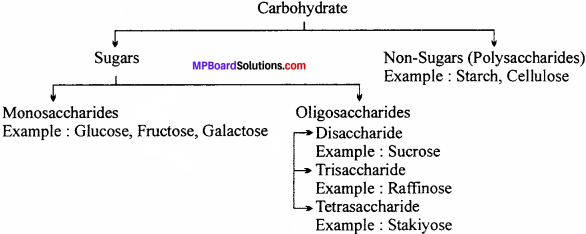
Functions of carbohydrates:
- It is the main structural component of cell.
- It acts as a bio-fuel and provides energy to organisms for doing work.
![]()
- Carbohydrate is stored in the liver as glycogen, which hydrolysis to provide the energy required.
- Cellulose is found in grass and plants which provide energy to animals grazing grass because these animals possess specific enzymes which hydrolyses cellulose to glucose.
Question 3.
Give the diseases caused by ascorbic acid, thiamine retinol and nicotinic acid.
Or
Give the source and diseases caused by Vitamin A, B, C and D.
Answer:
Name of Vitamins, its functions and deficiency diseases are given in the ahead chart: Chemical names of Vitamins, their sources, functions and diseases due to deficiency
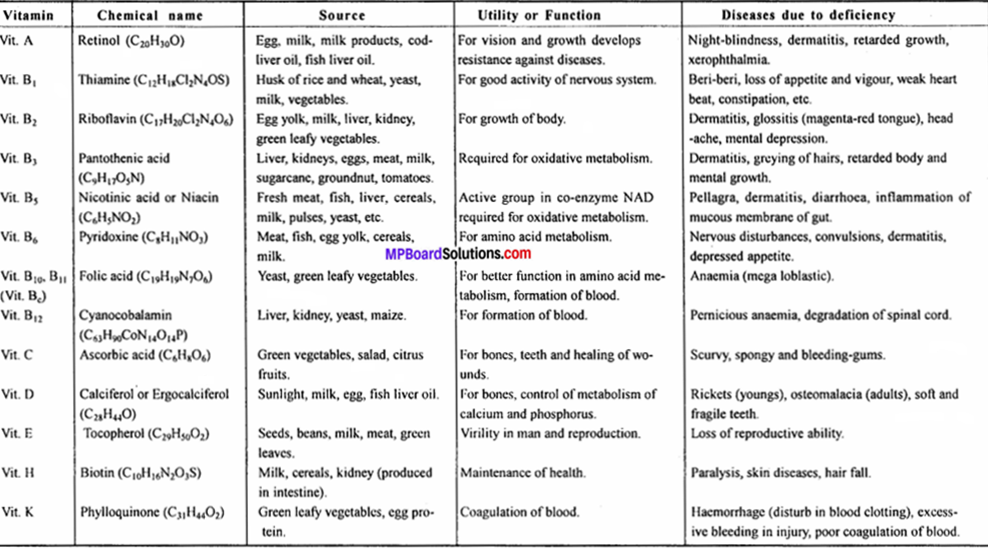
Question 4.
Give differences between monosaccharide, disaccharide and polysaccharide.
Answer:
Difference between monosaccharide, disaccharide and polysaccharide:
